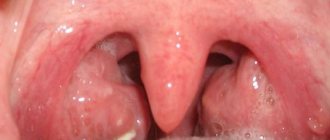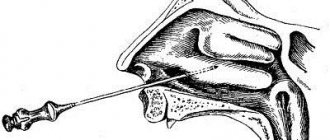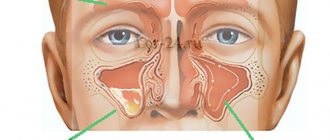Sinusitis is a serious disease, the characteristic feature of which is the development of an inflammatory process in the maxillary sinuses. The occurrence of this disease in almost every case is caused by a repeated runny nose or an untreated cold. Some people have the misconception that sinusitis can go away on its own, and if it is mild, then it may not even be treated.
In reality, things are completely different. A disease such as sinusitis must be treated without fail. Therapy must be started in a timely manner. Otherwise, serious complications cannot be excluded, which often occur in the form of independent pathologies and can cause the death of the patient. And if you ask the question: “Do people die from sinusitis?”, then the answer is obvious: such an outcome is possible, especially if the disease is neglected. Although in each specific case everything depends on the severity of the disease, the presence of associated pathologies, complications that have arisen and the individual characteristics of the body.
Reasons for the development of pathology
The main reason for the development of sinusitis is infection entering the nasal cavity with air or through blood. Among the indirect factors that cause impaired nasal breathing are deformation of the nasal septum, rhinitis, allergic reactions and adenoids in children. The state of the immune system plays an important role in the development of the disease.
There are many causes of sinusitis, including the following:
- injuries to the nasal mucosa;
- viral and bacterial infections entering the nasopharynx;
- colds;
- drafts;
- negative effects of chemical elements on the mucous membrane of the respiratory tract;
- neglected, damaged teeth;
- hypothermia of the body;
- weak immunity;
- nasal polyposis;
- adenoids;
- violation of the functional characteristics of the secretory glands;
- allergy.
Sinusitis can occur against the background of such dangerous pathologies as pulmonary tuberculosis, the development of cancerous tumors, or damage to the nasal mucosa by a fungal infection.
In addition to colds accompanied by nasal congestion, the cause of sinusitis is often sore teeth, especially the upper ones. Characteristic manifestations in this case are: the appearance of snot, the accumulation of mucus and the discharge of purulent secretion.
Lack of treatment: possible complications and consequences
Many people are interested in what will happen if sinusitis is not treated?
As mentioned above, the disease can be provoked by the impact of various viruses on the body. People who have caries or suffer from tonsillitis are also at risk. With this pathology, breathing through the nose is not possible. The person begins to breathe through the mouth, which poses a serious danger. This is explained by the entry into the lungs of cold air containing a large number of bacteria, as a result of which the respiratory tract becomes infected.
In addition, the inflammatory process begins to advance further, provoking more severe forms of the disease: sore throat, pneumonia and others, which answers the question of why sinusitis is dangerous. People with weakened immune systems may also be considered at risk. In this case, major organs such as the liver, stomach, brain and other vital systems of the body will be affected.
Over the course of a month, sinusitis has an acute form of the disease, after which it becomes chronic. If treatment is not started on time, there is a high probability of complications.
It is important to know! The more advanced the inflammatory process, the more difficult it is for the body to fight the infection. The resulting stagnation of secretions in the nasal cavity has a beneficial effect on the development of the disease.
It is known that sinusitis may not often be accompanied by complications. However, there is still a possibility that there may be negative consequences of sinusitis in adults.
The most common complications include:
Chronic sinusitis. It can be distinguished from the acute form of the course by several signs:- the disease progresses sluggishly, headaches and general malaise may occur periodically;
- The discharge has an unpleasant odor and contains pus.
- The main difference is that there is unilateral nasal congestion.
the temperature remains normal, although fatigue is felt;
- headache;
fear of light;
It is worth noting that the capabilities of modern medicine make it possible to cure any form of meningitis, but only if you seek help in time. Otherwise, the likelihood that death will follow is quite high.
Features of the development of the disease in children
The children's body is more often exposed to various inflammatory and viral diseases than adults. As a result of untimely and incomplete treatment, infections can be complicated by sinusitis. Infants are not susceptible to this development of pathology, since at this age the maxillary sinuses are not yet sufficiently developed.
From the age of four, the likelihood of the disease in children increases significantly. Due to the fact that the sinuses are still small, the onset of symptoms may not be the same as in an adult. It is important not to ignore or ignore a lingering runny nose. Among the main complications of sinusitis in a child are otitis media. This is due to the fact that the nasal and ear passages are close to each other.
In addition, children are much more likely than adults to suffer from ear inflammation. This is another reason to start treatment for sinusitis in a timely manner. Pay close attention to nasal discharge, and if it lasts more than a week, consult a doctor immediately. The presence of a greenish-yellow color or an unpleasant odor is also a sign that medical attention is needed.
In childhood, sinusitis may not always be accompanied by pain and fever. However, frequent complications cannot be excluded, such as:
- bronchitis and pneumonia;
- otitis, frontal sinusitis;
- transition from acute to chronic form;
- damage to internal organs;
- blood poisoning.
The main thing is not to forget that at the slightest suspicion of sinusitis, you need to contact a specialist.
It is important to know! Purulent inflammation can significantly lead to deterioration of health. Often accompanied by disturbances of consciousness.
Symptoms
Typical signs of the disease include the following:
- pressure in the bridge of the nose, increasing when the head is tilted;
- headache;
- loss of smell;
- poor sleep;
- poor appetite;
- nasal voice;
- the occurrence of pain in the temporal region and bridge of the nose;
- cough;
- runny nose;
- pain in the nose, forehead, gums and eye sockets;
- increase in body temperature up to 38 degrees;
- chills;
- absent-mindedness;
- fast fatiguability;
- loss of performance.
When faced with symptoms of the disease such as a runny nose and nasal congestion, few people think about whether it is possible to die from sinusitis.
The patient puts off visiting the doctor, hopes that the disease will go away on its own, and uses inappropriate drugs or folk remedies for treatment. It is this attitude that leads to disastrous consequences.
How to use mumiyo and glycerin for sinusitis?
Question:
Hello, Doctor! My name is Maria Fedorovna, I am 57 years old. I have been suffering from chronic sinusitis for more than 10 years, and I heard that in this case, mumiyo with glycerin helps well. Tell us in more detail how to properly use mumiyo and glycerin for sinusitis?
Answer:
Hello, Maria Fedorovna! Indeed, the medicine for sinusitis with mumiyo and glycerin has been known among the people for a long time and is successfully used in practice, because it can have a bactericidal, anti-inflammatory, analgesic and immunostimulating effect on the human body. Nasal drops are prepared based on these two components. To do this, take peach or apricot oil, separately mix 3 grams of mumiyo, the same amount of glycerin and distilled water. Next, you need to combine the prepared mixture with oil, it will have a softening effect on the nasal mucosa.
Prepared drops based on mumiyo and glycerin for sinusitis should be instilled three times a day for 2-3 months, after which you will forget about such a chronic disease for a long time.
It is worth noting that mumiyo and glycerin are not only used for sinusitis. You can also combine mumiyo with natural honey, provided that you are not allergic to honey or bee products. To prepare such a remedy, you should take 0.2 grams of mumiyo and dissolve it in a tablespoon of water, add a little honey. The prepared drops can be instilled into the nose 3-4 times a day, or small cotton wool pads can be soaked in this solution and placed one in each nostril for 5-7 minutes.
In addition, external use of mumiyo should be combined with internal use for the treatment of sinusitis. It is recommended to take 0.2-0.5 grams of this product per day in combination with plain water, honey or milk in the morning on an empty stomach.
gajmorit.com>
Probability of death from sinusitis
The best results are obtained by treating sinusitis at the beginning of its development. In this case, there is virtually no risk of death. If measures are taken in time, it is quite possible to exclude the development of complications. If you leave everything to chance, then most likely sinusitis will turn from an acute form into a purulent one, which is precisely fraught with the development of other, no less serious diseases.
The pathology in its acute form is characterized by active inflammation of the mucous membrane of the maxillary sinuses, which affects the vascular network and connective tissue. Chronization of the process is accompanied by damage to the maxillary walls and submucosal tissue.
The probability of death in severe forms of sinusitis is about 80%.
The most dangerous sinusitis manifests itself in a latent form. The pathology is asymptomatic, patients only experience increased fatigue and fatigue.
With a timely diagnosis and early contact with an otolaryngologist, sinusitis is completely cured, leaving no changes in the body
Bad habits
Bad habits pose a significant threat to human health:
- Smoking during sinusitis provokes the transition of the acute form of the disease to chronic. Against the background of the disease, the likelihood of developing cancer under the influence of nicotine increases.
- Drinking alcoholic beverages leads to vasodilation, which facilitates the penetration of infection into the blood and reduces the body's defense against the pathogenic agent. Antibiotic therapy in this case loses its effectiveness.
The presence of bad habits significantly increases the likelihood of death due to sinusitis. This fact must be taken into account when treating pathology.
Serious complications
Death from sinusitis can occur in case of inadequate treatment , as a result of which serious complications were allowed to develop.
Inflammation of the maxillary sinuses can provoke the occurrence of dangerous conditions , often representing diseases with an independent course, including:
- meningoencephalitis;
- development of a purulent inflammatory process in the maxillary bones;
- damage to the visual organs (thrombosis of the orbital veins, swelling of the eye tissue);
- complications on the kidneys, liver, heart muscle;
- dysfunction of the respiratory system;
- blood poisoning (sepsis).
The most dangerous cases are brain damage and infection of the patient’s blood. The disease progresses very quickly and the likelihood of death is very high.
That is why it is necessary to treat sinusitis in a timely manner. In this case, conservative methods are used and laser therapy is performed. In more complicated cases, rinsing of the nasal sinuses is prescribed or a puncture is made.
Do people die from sinusitis?
It is not the inflammation itself in the maxillary sinuses that is fatal, but the complications that it causes. The infection that causes the disease can affect not only neighboring tissues, but also enters the blood and spreads throughout the body. Maxillary sinusitis is life-threatening only if it is not treated properly. To think that it will go away on its own is stupid. If treatment is started on time and all recommendations of a specialist are followed, the disease will not leave any consequences in the body. Sinusitis can become chronic if it is not treated the first time or if the body is overcooled.
With this disease it is very difficult to destroy the source of inflammation. In some cases, antibiotics may not work. If a person has a weak immune system, any infection can cross the protective lining of the brain and cause meningitis. Sometimes simple tooth decay is enough. Asking the question “Do people die from sinusitis?” It should be understood that having started the disease, you need to be prepared for a disastrous result. Inflammation in the maxillary sinuses can be fatal. What symptoms indicate that complications are occurring:
- pain and swelling of the face;
- deterioration of vision and hearing;
- swelling of the eyelids and conjunctivitis;
- loss of taste.
If any of the signs appear, you should immediately consult a doctor. The development of the disease in a child or pregnant woman requires quick and timely treatment.
Sinusitis and bad habits: are they compatible?
Today there is active promotion of a healthy lifestyle. Taking many medications involves completely eliminating alcohol and nicotine .
Sinusitis and smoking are two completely incompatible concepts. Long-term scientific research has confirmed this.
Scientists have found that inhaled tobacco smoke, passing through the cavity of the nasopharynx, contaminates the mucus, complicates its natural outflow and thereby leads to inflammation of the mucous membranes.
Smoking with sinusitis can contribute to the transition of a simple runny nose into chronic sinusitis. And prolonged abuse of nicotine, over time, can even lead to cancer of the paranasal sinuses.
Alcohol and sinusitis are also incompatible. Quite often, at the first signs of a cold and the appearance of a runny nose, patients begin to “warm up from the inside.” This cannot be done if you have sinusitis. Since alcohol has a vasodilating effect, swelling of the mucous membranes can only increase, and breathing can become even more difficult. Drug treatment, in particular antibiotics, also becomes impossible.
What is sinusitis and its possible complications
Sinusitis is a diagnosis given to people who have inflammation of the paranasal sinuses. The reasons for its occurrence can be varied:
- penetration of a bacterial or viral infection into the nasal cavity;
- complications after colds;
- diseases of the upper molars;
- allergy.
Headaches with sinusitis, chills and difficulty breathing through the nose are the main symptoms of this disease. In addition, patients often complain of general weakness, increased body temperature, swelling and redness of the eyelids.
The greatest danger is hidden sinusitis, when its symptoms are not invisible and are similar to ordinary fatigue.
Inflammation of the maxillary sinuses is not a harmless disease. The organs and tissues located in close proximity to the lesion are most susceptible to complications. Untimely or unqualified treatment can lead to:
- purulent lesions of the bones of the upper jaw;
- diseases of the organs of vision: swelling of the tissue and thrombosis of the veins of the orbit, damage to the optic nerve;
- brain damage: meningitis, less commonly, meningoencephalitis;
- complications from internal organs: heart, liver, kidneys, respiratory organs.
The greatest danger is brain damage, which requires the fastest possible decision-making - unfortunately, death from sinusitis in this case is not uncommon.
Otitis
The most common form of complication is otitis media. The infection enters the ear due to blowing the nose. At this time, the pressure in the nasopharynx increases, and mucus with microbes enters the ear auditory tube. A feeling of stuffiness in the ear begins to arise, then a painful sensation that begins to bother you in the evening and at night. Painful symptoms intensify and then become unbearable. Purulent discharge appears from the ear canal. The development of stagnation and tissue swelling occurs due to chronic diseases of the maxillary cavities.
On topic: 9 mistakes that prevent you from growing:
When an infection enters the bloodstream, the brain is affected. The pathogen spreads quite quickly throughout the body. Complications occur: meningitis, meningoencephalitis, sepsis. If these infections are detected, urgent hospitalization is required.










